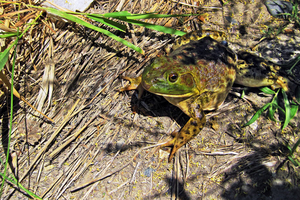Ravenous bullfrogs invade Yellowstone River
The number of breeding sites for the animals almost quadrupled between 2010 and last year, to 45.

A bullfrog rests along the Yellowstone River near Billings, Mont., in 2013. Scientists say an invasion of voracious American bullfrogs is spreading downstream along Montana’s Yellowstone River and poses a potential threat to native frogs.
US Geological Survey/AP
BILLINGS, Montana
An invasion of American bullfrogs that will eat just about anything — including each other — is spreading downstream along the Yellowstone River in the northwestern state of Montana and poses a potential threat to native frogs, government scientists said.
Bullfrogs were found in recent surveys along a 66-mile (100-kilometer) stretch of the river from the Laurel area downstream to Custer, U.S. Geological Survey biologist Adam Sepulveda said Thursday. The number of breeding sites for the animals almost quadrupled between 2010 and last year, to 45.
"They are going to eat anything they can fit into their mounts. It doesn't matter if it's another frog or a bird or a mosquito," said Sepulveda, who co-authored a study on Yellowstone River bullfrogs appearing in the journal Aquatic Invasions.
Bullfrogs as long as 12 inches (30 centimeters) when outstretched have been found. One that was caught and cut open near the Audubon Conservation Center in Billings last year had an oriole in its stomach.
State and federal agencies initially tried to stop the invaders in their tracks by killing them all off, but gave up after the number of bullfrogsoverwhelmed the effort. They're now trying to come up with a strategy to at least contain their spread.
Bullfrogs are native to the eastern U.S., but are known to have been spread by humans to every state except North Dakota.
They've caused problems elsewhere by preying on native frogs, out-competing other animals for food, and spreading a fungus that's suspected as a cause of a widespread decline in amphibians, Sepulveda said.
They were first documented in eastern Montana in 1999. Scientists believe they descended from released pet frogs or bullfrog tadpoles used as bait by fishers.
Another population recently has been documented in eastern Montana, according to authorities.
The frogs have inhabited areas of western Montana since the 1920s, likely from a farming operation that sold their legs to be eaten, Sepulveda said.

